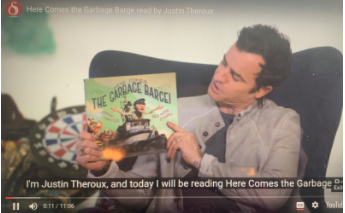
Storyline Online

Overview
Storyline Online is a free interactive site that features videos of celebrated actors reading children's books. They are creatively produced with motion graphics which include visual effects such as camera pans, movement, music, and sound effects.
Note: This can be used with Pre-K - 12th graders.
Learning Objectives
Students will:
-
Be able to watch/listen to the storybook, "Here Comes the Garbage Barge!"
-
Be able to tap prior knowledge/build background through class discussion.
-
Be able to explain how the illustrations contribute to what is conveyed by the words in the story.
-
Be able to determine the author’s purpose.
-
Be able to answer the prompt using at least two details from the text to support the response.
-
Be able to create an advertisement piece using grade-appropriate sentence structure and spelling.
Vocabulary
Vocabulary Words:
- Historical Fiction: Historical fiction is a made-up story but is set in the past.
- Author’s Purpose: The author’s purpose is the main reason why the story was written.
Pre-planning
To prepare for this lesson:
-
Watch this introduction tutorial for an overview of Storyline Online KTLA Interview.
-
Go to the website Storyline Online and select the book, “Here Comes the Garbage Barge”. Copy and paste the link into Google classroom or your website so the students can access it.
-
Next, print out the activity guide for the book (s) you have selected. Under the activity guide, click on for teachers.
-
Prepare by writing the following on chart paper.
-
Chart paper with the following questions written:
-
Did the author describe real or imaginary characters? Places? Events?
-
Did the author try to make me laugh? (entertain) - Did the author tell me a story? (entertain or explain)
-
Did the author give me facts? (inform)
-
Did the author try to teach me something? (inform)
-
Did the author try to change my opinion about something? (persuade)
-
-
Three Column Chart (Persuade – Inform – Entertain)
-
Accommodations
See Accommodations Page and Charts on the 21things4students.net site in the Teacher Resources.
Steps
Directions for this activity:
-
You can choose to do this activity as a whole group or students can do it independently. I chose the whole group. Students will come to the carpet and discuss the before reading steps 1-6 from the activity guide (tapping into prior knowledge).
-
Next, I will play the book aloud on the big screen. Students will explain how the illustrations contribute to what is conveyed by the words in the story. (see during reading in lesson plan)
-
After reading the story, students will determine the author’s purpose (see after reading in the lesson plan).
-
Students will head back to their seats and work on their reading responses individually. This is why I posted the link in Google classroom, so the students can go back and listen to the story again online in order to provide evidence.
-
Students will answer the prompt using at least two details from the text to support the response.
-
Prompt: How does the author provide information or details to make the story seem realistic.
-
-
If time allows or you can choose another day - there is a writing/art activity on the lesson page that the students can do. Students will create an advertisement piece using grade-appropriate sentence structure and spelling.
Assessment Options
Different options for assessing the students:
- Observations
- Check for understanding
-
Discussions with the class or you can grade their responses to the prompt questions.
MITECS Competencies & ISTE Standards
MITECS: Michigan adopted the "ISTE Standards for Students" called MITECS (Michigan Integrated Technology Competencies for Students) in 2018.
Empowered Learner
1a. Students articulate and set personal learning goals, develop strategies leveraging technology to achieve them and reflect on the learning process itself to improve learning outcomes.
1c. Students use technology to seek feedback that informs and improves their practice and to demonstrate their learning in a variety of ways.
Knowledge Constructor
3a. Students plan and employ effective research strategies to locate information and other resources for their intellectual or creative pursuits.
3d. Students build knowledge by actively exploring real-world issues and problems, developing ideas and theories and pursuing answers and solutions.
Devices and Resources
Device: PC, Chromebook, Mac, iPad
Browser: Chrome, Safari, Firefox, Edge, ALL
App, Extension, or Add-on:
Websites:
Storyline Online
CONTENT AREA RESOURCES
ELA
Students will tap into prior knowledge, explain how illustrations contribute to the book, and determine the author’s purpose in writing the story.
Integrated Arts
Students will create an advertisement piece using recycled items from home.
Science
Students will learn about recycling and how that affects our world.
Credits
This task card was created by Dawn Phillips, Wyoming Public Schools, June 2020.


